Beartooth Climbing
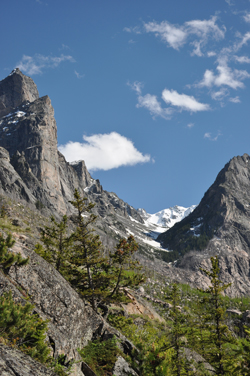
The Doubletts, Snow Creek Drainage
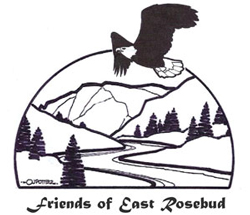
Sign Petition to preserve East Rosebud Canyon
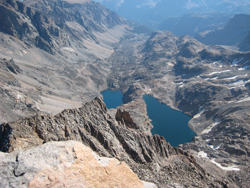
Granite Lake as seen from Granit Peak
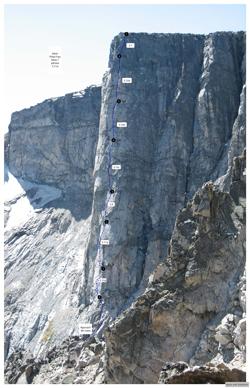
Freesilver on Silver Pillar
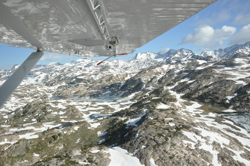
High over the Beaten Path

Clint Branger resting under the Arch
-
Betaflash
All topos on this website have been created with Betaflash. Thanks a lot for providing this free software.
A Selection of Climbs in the Beartooth Wilderness
This guide describes selected climbs in the Beartooth Wilderness in Southern Montana. The area is located right north of Yellowstone National Park and is part of Custer National Forest. Beartooth Wilderness consists of 950,000 acres of pristine alpine tundra. The main plateau is 9 - 10,000 feet high with peaks up to 12,800 ft/3900 m (Granite Peak, highest point in Montana). Glaciers are almost gone but high peaks still keep their snow cover into late summer. Streams and rivers carved out deep canyons and exposed steep cliffs of rock that is more than 3 billion years old. The area is well known to hikers and fishermen for its well maintained trails with hundreds of lakes and abundant wildlife. But the Beartooth Mountains offer excellent opportunities for climbers of all levels of expertise too. Most climbing is on solid granite or gneiss. The views are breathtaking. Although, approaches and descents can be long and adventurous. Bolts are only found on cliffs outside the Wilderness boundary and pitons are very rare throughout the area. This together with high altitude and quick weather changes keeps the crowds away. And it opens up rare opportunities for nature loving climbers that know how to navigate alpine terrain. This is an area for adventurous climbers that donít mind to get lost and even like the challenge to find their way again.
Read this before you continue:
This guide has been assembled for experienced climbers. All information given is to the best knowledge of the author. However, you should always assume that all you read here is wrong and you have to find your own way. Climbing is a dangerous sport that can lead to injury or death. If you do not have the proper training and equipment you should consult an expert before you commit to any of these climbs or even try to find the approaches.
Beartooth Wilderness
Location:
A good starting point for adventures in the Beartooth Mountains is Red Lodge, Montana, which is about an hour drive from Billings International Airport. The routes described here start at Forrest Service Trail Heads on West Fork of Rock Creek, Lake Fork and East Rosebud Canyon all located south and west of Red Lodge, Montana. There is a variety of Campgrounds available at all three locations. More luxurious accommodation, dining, and shopping are available in town. The US Forrest Service Map: ďAbsaroka Beartooth WildernessĒ gives a good overview over the area.
Season and Weather
Rock climbing season is May to October for the low elevation cliffs, July to September for the high country. Early season sees frequent afternoon thunderstorms. Later it is usually warm and dry. But weather out here is always good for a surprise. I remember sweating on the last pitches of the Doublett at 10,000 ft in June as well as fighting snow at 6,000 ft in August. Look up the weather for Roscoe, MT 59071 or check our Web Cam for local weather conditions.
Geology
If you want to climb the oldest rock on earth: Come here. The Beartooth Mountains date back to the Archaean geological epoch 2.5-4 billion years ago. Climbs described on this web page are on cliffs made of Archean Granitoids (this includes Granite, Grandiorite and other related igneous rocks) and various Gneisses of the same age. This rock is about 20 times older than Half Domes Grandiorite in Yosemite! And it is rock solid. But as it is with old things: They get wrinkly (which makes nice knobby hand and foot holds) but sometimes also crumbly. Watch out for yellow discoloration. This rock might have decomposed over the years and its surface turned into loose flakes and crumbles. Described climbs are solid if not indicated otherwise. But if you get off-route you might get into this stuff.
On the edges of the Beartooths are limestone, sandstone and other sedimentary rock cliffs too. I might report on those if I had a chance to explore them a bit more. The Beartooth Geology paragraph has been writen by Meike Annighofer.
Climbing:
Donít expect to find bolts or pitons or any other fixed protection on the high country cliffs. This is all old school traditional climbing. You will be on your own for protection. Bring a full set of stoppers from tiny brass to 1 inch with the doubles for the mid sizes and 2 sets of cams from very small to 2 inch (#2 Camelot). One #3 can be helpful sometimes. If larger sizes are needed it is indicated in route descriptions. A 60m single rope works fine. A double or twin of the same lengths, however, offers longer repels for retreats in bad weather or climber condition. And donít forget your helmet, rain gear, etc. If you don't know what I mean better stay home.
Your help wanted:
This site is still work-in-progress. I hope it will always be. Progress will depend on you. Please help with contributing more route desriptions. And of course: Don't be mad if I have gotten something wrong (first ascent data, rating, etc.). Let me know and I will try to fix it.
Leave no Trace:
Always remember: The Beartooth Mountains are designated Wilderness. This means you should leave no trace of your visit. Everything you pack in you must pack out again. Human waste should be buried at least 6-8 inches and 300 ft from any water and toilet paper carried out. Camps should be set up at least 100 ft from any lake or stream. For more details contact Custer National Forest.
Guide Books:
Alpine Ice and Rock Guide to SW and Central Montana by Ron Brunckhorst
This book published in 2000 is the only worthwhile printed guide to the area. It includes a lot of climbing history and good old stories.
The Rock Climbers Guide to Montana by Randall Green
This nice selection of Montana Rock Climbs published by Falcon Press in 1995 covers Granite Peak but ignores the rest of the Beartooth Wilderness.
Hiking the Absaroka-Beartooth Wildernessby Bill Schneider
Another excellent Falcon book from 2003 (second edition). It focuses on hiking but contains a lot of worthwile information for all visitors of the area.
Contact:
Sorry, no link here. You have to retype e-mail
-
All rights reserved by Wood & Iron Works, 2011